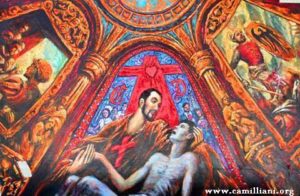Fr. Laurent Zoungrana
Introduction
 At the outset a note by way of information: I take up in this paper a large part of a previous work of mine. And I apologise at the outset if my words are addressed more to our religious world rather than to the world of our family of lay faithful.
At the outset a note by way of information: I take up in this paper a large part of a previous work of mine. And I apologise at the outset if my words are addressed more to our religious world rather than to the world of our family of lay faithful.
The following subject was assigned to me: ‘Being a Camillian and a Samaritan in Today’s World’. This subject demonstrates the importance of the gospel parable of the ‘Good Samaritan’ (Lk 10:25-37) in the life of ‘Camillians’ in the contemporary world. In saying ‘Camillian’ there is the risk of thinking only about ‘religious, the Ministers of the Sick’. In our context, the term ‘Camillian’ is not limited to a religious who claims that be belongs to St. Camillus. It refers, rather, to every person, whether religious or lay, who seeks to live the charism that St. Camillus received from God in the Church and transmitted to the world. In this sense, we can say that every member of the Lay Camillian Family is a ‘Camillian’ because they live the charism of St. Camillus. We should not forget that ‘At the beginning of the life of the Order, indeed, St. Camillus involved in the service of care for the sick a group of lay men, aggregating them to the Institute’ (Fr. Angelo Brusco, Statuto Generale Famiglia Camilliana. “Presentazione”, Rome, 1998, p. 4.). Even before that ‘a priest and four lay men adhered to the project of Camillus’ (Lettera della Consulta Generale nel documento: “1591-1991, La Famiglia Camilliana si confronta” a cura di Missione e Salute, 1991. p. 3). And as Father Emidio Spogli said: ‘After his first ‘Company’ had been transformed into a religious Order, he was concerned that activity involving charity might in this way be restricted and for this reason he asked for, and obtained, the faculty to aggregate and to bring together in a ‘Congregation’ lay people, clerics and priests who would exercise ‘the same pious works of mercy and charity’, and thus be able to reach a greater number of sick people, multiplying the opportunities for service of his community’ (La Famiglia Camilliana. A cura di P. Emidio Spogli. Estratto “Camillo de Lellis – Un santo per chi soffre, second edition, casa editrice Tinari, Bucchianico, 1995, p. 9). Taking into account this historical observation, ‘Camillian’ here means a lay person or a male or female religious or a priest who are called in their state to live the charism of St. Camillus, that is to say ‘the merciful love of Christ for the sick’ (Costituzione e Disposizione Generali, Ministri degli Infermi, Casa Generalizia, Rome, 2017. art. 1, p. 13).
In addressing this subject, I would like first of all to re-read the Parable of the Good Samaritan (I), then apply it to St. Camillus and Camillians (II), and, lastly, to consider one of the figures of the parable (the innkeeper) as representative of Camillians, to whom are entrusted the charism of St. Camillus and Camillian service (III).
A Re-Reading of the Parable of the Good Samaritan
The parable of the Good Samaritan, which is narrated only by Luke the Evangelist, is placed between the Gospel of the return from their mission of the seventy-two disciples and that of Jesus in  the house of Martha and Mary. The seventy-two disciples, after preaching the nearness of the Kingdom of God (Lk 10:9), offering peace (Lk 10:5), and inviting people to convert and accept Jesus the Saviour, return full of joy (Lk 10:17). One may say that the parable of the Good Samaritan, which comes immediately after the mission of the disciples, illustrates the behaviour that one should have towards one’s neighbour after receiving the Kingdom of God in Jesus, which is a kingdom of love. The parable thus illustrate the practice or non-practice of the commandment to love one’s neighbour, which allows us to enter, or not to enter, eternal life. It demonstrates to man the will of God who ‘asks from man a total love that in practice is generous help for a travelling companion who is in need’ (I Vangeli, traduzione e commento a cura di Giuseppe Barbaglio, Rinaldo Fabris, Bruno Maggioni, Cittadella Editrice, Assisi, 1978). This love for one’s neighbour extends as far as welcoming the needy into one’s own home, into one’s own life, as the passage on Jesus as a guest in the house of Martha and Mary enables us to perceive.
the house of Martha and Mary. The seventy-two disciples, after preaching the nearness of the Kingdom of God (Lk 10:9), offering peace (Lk 10:5), and inviting people to convert and accept Jesus the Saviour, return full of joy (Lk 10:17). One may say that the parable of the Good Samaritan, which comes immediately after the mission of the disciples, illustrates the behaviour that one should have towards one’s neighbour after receiving the Kingdom of God in Jesus, which is a kingdom of love. The parable thus illustrate the practice or non-practice of the commandment to love one’s neighbour, which allows us to enter, or not to enter, eternal life. It demonstrates to man the will of God who ‘asks from man a total love that in practice is generous help for a travelling companion who is in need’ (I Vangeli, traduzione e commento a cura di Giuseppe Barbaglio, Rinaldo Fabris, Bruno Maggioni, Cittadella Editrice, Assisi, 1978). This love for one’s neighbour extends as far as welcoming the needy into one’s own home, into one’s own life, as the passage on Jesus as a guest in the house of Martha and Mary enables us to perceive.
Therefore to the question of the lawyer ‘what must I do to obtain eternal life?’, Jesus in a practical way demonstrates through the parable of the Good Samaritan what one must do to merit entering eternal life and give proof of acceptance of the preaching of the Kingdom of God. In this parable, if we leave to one side the robbers and the unfortunate man, we see that Jesus brings onto the scene four characters: the priest, the Levite, the Samaritan and the innkeeper, and we can already sense that at the centre of the parable there is his person and his message of mercy.ù














Camillians on Facebook
Camillians on Twitter
Camillians on Instagram